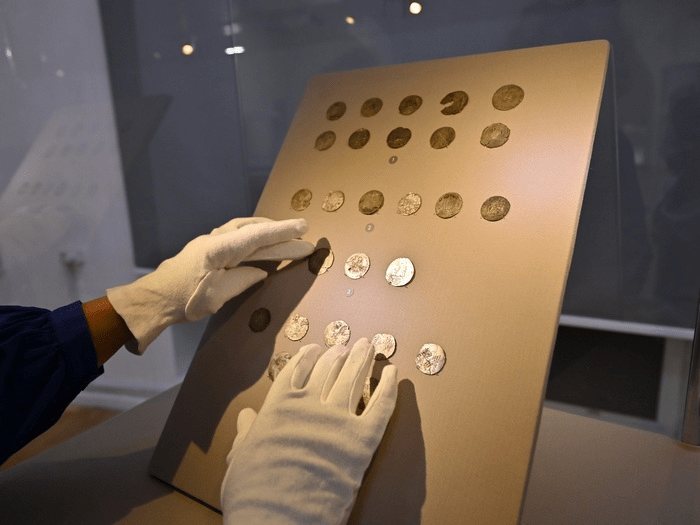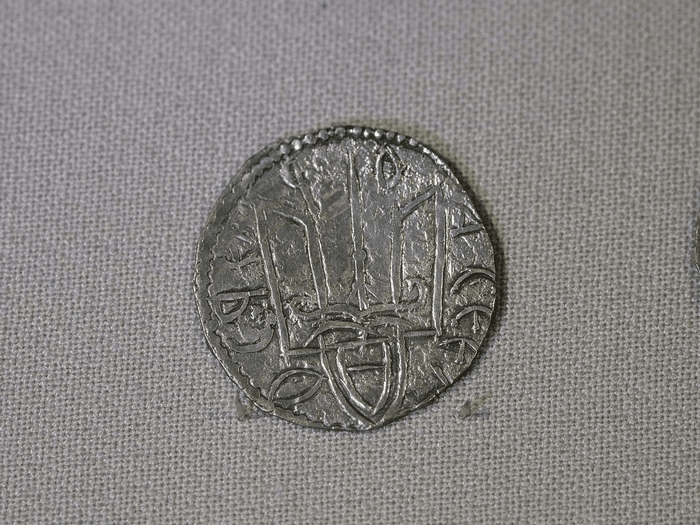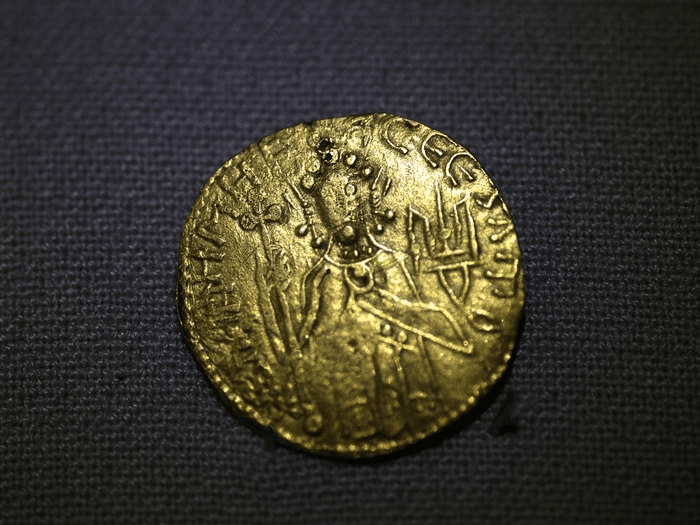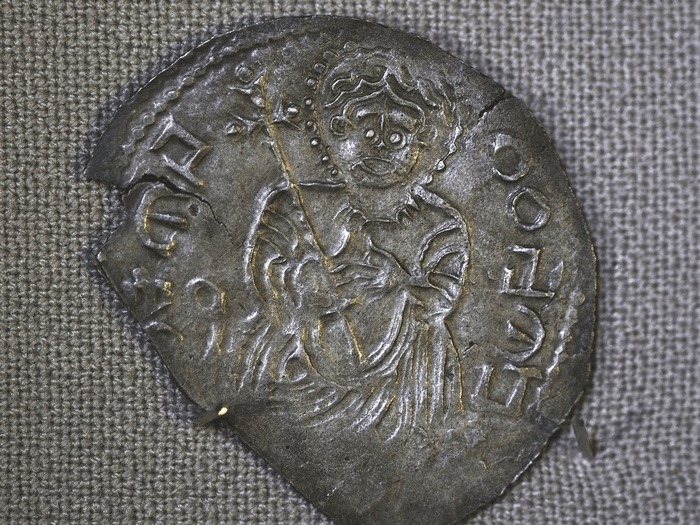The National Museum of History of Ukraine opened the exhibition "Treasures of Ukraine. Symbols of Statehood," which for the first time showcases a treasure found in 2020 near the village of Horodnytsia in Zhytomyr Oblast by local resident Serhiy Komar — 35 coins and two fragments, dated to the late 10th - early 11th centuries (that is, the period of the reign of the great prince of Kyiv, Volodymyr, who baptized Rus). The exhibition (dedicated to Ukraine's Independence Day) also features other coins from the time of princely Rus from the museum's collection, including a very rare gold coin. It was minted during the reign of Prince Volodymyr from gold, which was extremely scarce in princely Rus at that time. It's no surprise that the fingers of both hands are enough to count all the known gold coins to date. Earlier, a displaced person from Mariupol found ancient jewelry in Ternopil Oblast.
"The Horodnytsia Treasure is, without exaggeration, a sensation"
At the exhibition opening, Serhiy Komar was present, who found the Horodnytsia treasure in 2020.
- I was collecting sand in the forest to mix it with cement (for home work), and at a certain depth, I came across soil that was darker than the surrounding one, - said Serhiy Komar about the circumstances under which he found the ancient coins. - The dark color of the sand was given by the ancient silver coins. They then had an unpresentable appearance — black, dirty. I contacted historian Oleksandr Alforov through acquaintances, and he came to me.
Archaeological research at the site of the find was conducted by scientists led by candidate of historical sciences Andriy Petrauskas. He is currently also in the ranks of the Defense Forces of Ukraine but found an opportunity to come to the exhibition opening.
- The name of the village Horodnytsia led scientists to suggest that there was a fortified settlement during the times of princely Rus there, - said Andriy Petrauskas. - Several generations of archaeologists have tried to find it. I was involved in this too. And here, the accidental discovery of coins by Serhiy Komar hinted at where exactly to search for the settlement. And we found it. But this is not enough — it is necessary to thoroughly study its remains. By the way, there is a version that it was the capital of the principality. Regarding the coins, it is worth saying this: over many decades of research throughout Ukraine, scientists from the Institute of Archaeology of the NAS of Ukraine have found only one item identified as a silver coin of the princely era. This fact vividly illustrates how significant the discovery of the treasure of silver coins near the village of Horodnytsia is. It is a real scientific sensation.
The curator of the exhibition "Treasures of Ukraine. Symbols of Statehood," candidate of historical sciences, head of the department, Zinaida Zrazyuk answered the questions.
— Was the restoration of the silver coins found in 2020 near Horodnytsia a difficult task?
- Yes, it is a very complicated job because this is ancient silver. It can delaminate over many centuries. These coins were covered with a very thick layer of oxides. It was necessary to remove them in such a way as not to damage the image. Thanks to the fact that we have first-class restorers working with us, we managed to successfully cope with this task and preserve the integrity of the coins. But they are very fragile. So, it is necessary to work with them as carefully as possible.
"It is quite possible that Prince Volodymyr ordered the minting of coins from gold in honor of the baptism of Rus"
— Did these silver coins lose some weight after a very long stay in the ground and restoration?
— We do not know this, as it is unknown how much they weighed 1000 years ago when they were new. It is also important to note this: several coins from the treasure were found heavily deformed. The restoration council decided whether to straighten them. After careful study of this issue, they concluded that they would not straighten them because they could lose these coins. So, they left them bent.
— What are the scientists' assumptions regarding how the treasure ended up in that area?
— The answer to this question was provided by archaeological research conducted in the area where this treasure was found. Nearby, they managed to excavate the remains of a princely settlement. That is, there was a settlement on the bank of the river, where merchants lived, and someone among them, for one reason or another, buried the silver coins, but it was not destined for them to take them back.
— Were thirty-five coins and two fragments that make up the Horodnytsia treasure big money in princely times?
— Considerable. It should be understood that the amount of silver coins in circulation at that time was limited. That is, there were not many of them. And this may indicate that the environment of people among whom these coins circulated was quite limited. We are primarily talking about merchants and people in the service of the prince.
— Under which specific princes were the coins from the Horodnytsia treasure minted?
- During the reign of Prince Volodymyr Sviatoslavich (979 — 1015 years of rule), Sviatopolk the Accursed (1015 — 1019 years of rule), and the mysterious Kyiv prince named Petor (most likely, Petor is the Christian name of Sviatopolk). Part of the silver coins depicts the Apostle Peter — the heavenly patron of Prince Petor.
— If Petor is the Christian name of Sviatopolk, then, presumably, this is the same Sviatopolk the Accursed?
— It is not excluded. At least stylistically, all these coins from the treasure are very similar. Most likely, they were minted by the same masters.
— I will also ask about the gold coin presented at this exhibition. What was the occasion for these very rare coins to be made?
- First, I will say that there are 10 gold coins of princely Rus preserved in the museums of the world. There was one more, but it has been lost.
Now, regarding your question. According to one version, the gold coins were minted on the occasion of the baptism of Rus. It is known that the great prince Volodymyr was initially a pagan. When he conquered Kherson, which was located in Crimea, he accepted Christianity there. After that, he married Anna, the sister of the Byzantine emperors Vasily II and Constantine VIII. He returned to Kyiv and conducted the baptism ceremony for the Kyivan people, starting the construction of the stone Desiatynna Church. The well-known gold coins also belong to this period. Hence the version — Volodymyr ordered the minting of coins from gold in honor of the baptism of Rus.
Previously, a mysterious artifact found by archaeologists in the Poltava region left scientists around the world at a loss.



